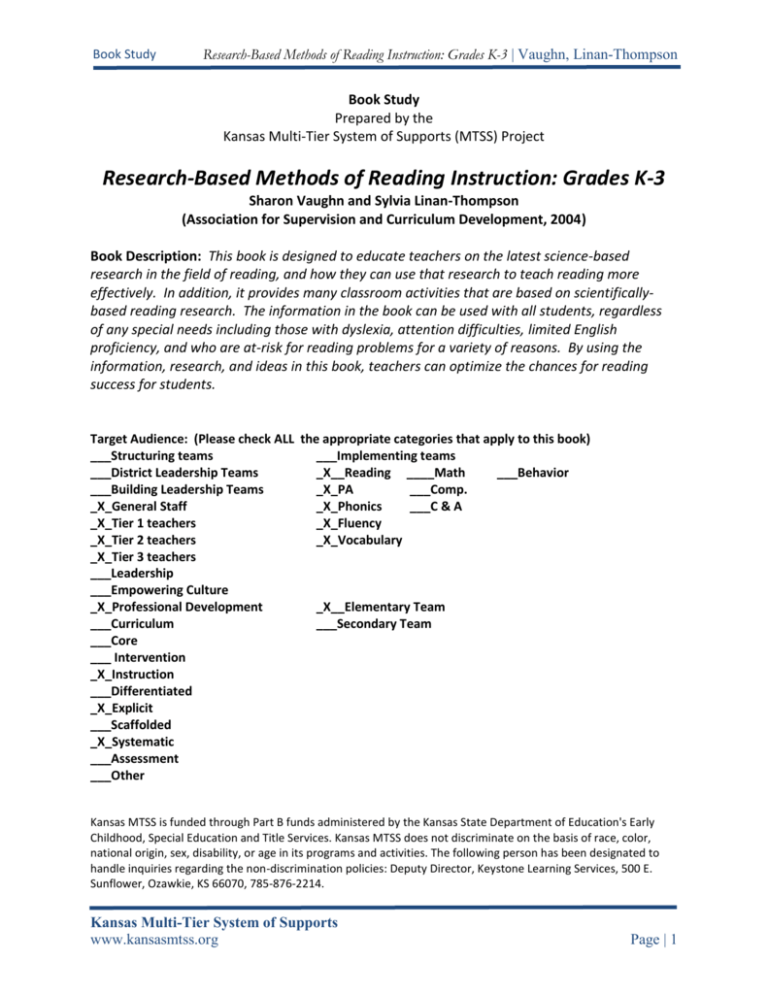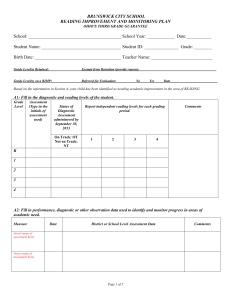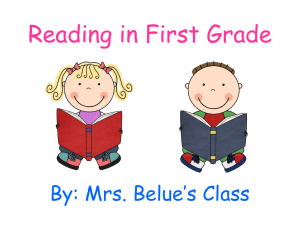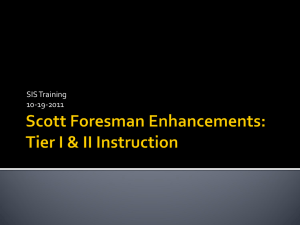Research-Based Methods of Reading Instruction
advertisement

Book Study Research-Based Methods of Reading Instruction: Grades K-3 | Vaughn, Linan-Thompson Book Study Prepared by the Kansas Multi-Tier System of Supports (MTSS) Project Research-Based Methods of Reading Instruction: Grades K-3 Sharon Vaughn and Sylvia Linan-Thompson (Association for Supervision and Curriculum Development, 2004) Book Description: This book is designed to educate teachers on the latest science-based research in the field of reading, and how they can use that research to teach reading more effectively. In addition, it provides many classroom activities that are based on scientificallybased reading research. The information in the book can be used with all students, regardless of any special needs including those with dyslexia, attention difficulties, limited English proficiency, and who are at-risk for reading problems for a variety of reasons. By using the information, research, and ideas in this book, teachers can optimize the chances for reading success for students. Target Audience: (Please check ALL the appropriate categories that apply to this book) ___Structuring teams ___Implementing teams ___District Leadership Teams _X__Reading ____Math ___Behavior ___Building Leadership Teams _X_PA ___Comp. _X_General Staff _X_Phonics ___C & A _X_Tier 1 teachers _X_Fluency _X_Tier 2 teachers _X_Vocabulary _X_Tier 3 teachers ___Leadership ___Empowering Culture _X_Professional Development _X__Elementary Team ___Curriculum ___Secondary Team ___Core ___ Intervention _X_Instruction ___Differentiated _X_Explicit ___Scaffolded _X_Systematic ___Assessment ___Other Kansas MTSS is funded through Part B funds administered by the Kansas State Department of Education's Early Childhood, Special Education and Title Services. Kansas MTSS does not discriminate on the basis of race, color, national origin, sex, disability, or age in its programs and activities. The following person has been designated to handle inquiries regarding the non-discrimination policies: Deputy Director, Keystone Learning Services, 500 E. Sunflower, Ozawkie, KS 66070, 785-876-2214. Kansas Multi-Tier System of Supports www.kansasmtss.org Page | 1 Book Study Research-Based Methods of Reading Instruction: Grades K-3 | Vaughn, Linan-Thompson -Chapter 1: Why Science MattersBrief Overview: Much research has become available regarding reading development and the instruction of reading. Although it is common to hear opposing viewpoints on the teaching of reading, teachers and administrators must begin to understand scientific educational research and implement practices supported by that research. Discussion Questions: 1. Why can understanding the science behind the teaching of reading be helpful in the profession of education? How are our current practices different than from what this chapter suggests? 2. What can teachers and administrators do to communicate the importance of using scientific evidence in their teaching decisions? 3. Provide examples of how “folklore” has been helpful and harmful in your own educational setting. 4. How is “craft” similar and different from “folklore”? Why is “craft” considered more compatible with science? 5. Read and think about the Carnine quote at the bottom of page 6. Discuss your thoughts on the implications of this quote for education as a profession. Kansas Multi-Tier System of Supports www.kansasmtss.org Page | 2 Book Study Research-Based Methods of Reading Instruction: Grades K-3 | Vaughn, Linan-Thompson -Chapter 2: Phonemic AwarenessBrief Overview: This chapter discusses what phonemic awareness is, its importance, how to assess it, and how to design instructional activities that are most effective for teaching these skills. There are examples of instructional classroom activities provided at the end of the chapter that can help guide teachers in planning instruction for developing phonemic awareness skills in children. Discussion Questions: 1. Why might it be difficult for children to learn to read if they don’t have solid phonemic awareness? 2. How can knowing about the importance of phonemic awareness help you adjust your current instructional practices? 3. Why is it important to have an effective system in place for determining these strengths and needs? 4. Evaluate the system your school currently has in place for determining which phonological awareness skills have been mastered, as well as which skills the students need. (For example, does this system allow you to predict who will have later difficulties in reading? Help you differentiate instruction? Tell you what skills you need to teach? Have multiple forms?) 5. Identify the main instructional factors when teaching phonemic awareness. How can you incorporate these factors in your own practice? Kansas Multi-Tier System of Supports www.kansasmtss.org Page | 3 Book Study Research-Based Methods of Reading Instruction: Grades K-3 | Vaughn, Linan-Thompson -Chapter 3: Phonics and Word StudyBrief Overview: This chapter provides an overview of phonics, how to assess it, a sequence of phonics skills, and the most effective strategies for teaching phonics. This chapter also includes examples of effective instructional activities, as well as guidance on how to develop activities for effective phonics instruction. Discussion Questions: 1. Explain the components of effective phonics instruction. Which components are and are not present in your own phonics instruction? 2. How can the knowledge of Gough and Tumner’s two basic reading processes inform your own design of phonics instruction for your students? 3. Summarize the progression of teaching phonics skills acquisition. Which teaching tips can you apply to your own phonics instruction? 4. Discuss how you monitor the progress of your students’ phonics mastery, what skills you are monitoring, and how you use that data to inform your instruction. How is your current practice different or the same as what the text suggests? 5. What are some difficulties that students may encounter if they do not receive explicit, systematic phonics instruction? Why might they have these difficulties? Kansas Multi-Tier System of Supports www.kansasmtss.org Page | 4 Book Study Research-Based Methods of Reading Instruction: Grades K-3 | Vaughn, Linan-Thompson -Chapter 4: FluencyBrief Overview: This chapter addresses fluency instruction. The topics discussed throughout the chapter are what fluency is, why it is important, and how to use progress monitoring to determine which students need additional fluency instruction. There are also fluency instructional activities provided at the end of the chapter. Discussion Questions: 1. What evidence is provided in Chapter 4 that supports the importance of including explicit fluency instruction in your reading instruction? 2. Discuss how to select the proper text for fluency instruction. 3. What are some problems with strategies such as Sustained Silent Reading, Drop Everything and Read, and Round Robin Reading for improving fluency? 4. List the critical elements that have been shown to improve reading fluency. 5. After reading the Fluency Instructional Activities, which do you see as most valuable for you in planning effective fluency instruction? Which might be the least valuable? Why? Kansas Multi-Tier System of Supports www.kansasmtss.org Page | 5 Book Study Research-Based Methods of Reading Instruction: Grades K-3 | Vaughn, Linan-Thompson -Chapter 5: VocabularyBrief Overview: This chapter explains why vocabulary instruction is important, how it contributes to comprehension, and how to implement effective vocabulary instruction into your classroom. Explanations of several vocabulary instructional activities are included at the end of the chapter. Discussion Questions: 1. Why might students with low oral vocabulary skills have difficulty comprehending text? 2. Compare explicit vocabulary instruction to implicit vocabulary instruction. How are these types of instruction alike and how are they different? Provide examples from your own practice in which you used each of these types of vocabulary instruction. 3. Provide an example of vocabulary words from your own grade level or content area, and classify them as Tier I, Tier II, or Tier III words. Why did you classify them the way you did? 4. After reading the questions on page 79, under the heading, “What Practices Can I Use to Teach Vocabulary Directly?” evaluate your current vocabulary instructional methods and explain how you might adjust them. 5. Provide an example of an effective vocabulary strategy that can help students understand what they need to do to learn new words on their own. Kansas Multi-Tier System of Supports www.kansasmtss.org Page | 6 Book Study Research-Based Methods of Reading Instruction: Grades K-3 | Vaughn, Linan-Thompson -Chapter 6: ComprehensionBrief Overview: Phonics and word reading are necessary foundational skills that lead to proficient reading. However, comprehension of the text is the ultimate goal. This chapter addresses the critical elements of comprehension, as well as how to assess and instruct students on comprehension strategies. Discussion Questions: 1. Why is the practice of asking questions at the end of a selection alone an inadequate method of comprehension instruction? 2. Use the bullet points on page 104, under the heading, “Instructional Factors” to evaluate your current practices for comprehension instruction. 3. Provide examples of reading comprehension intervention strategies that you currently use in your own instruction. Which comprehension intervention strategies can you add into your current instructional practices? 4. Explain why it’s important for students to know that reading requires active involvement with the text. 5. Which of the Instructional Activities would you like to incorporate into your own comprehension instruction? Which have you already used? Kansas Multi-Tier System of Supports www.kansasmtss.org Page | 7 Book Study Research-Based Methods of Reading Instruction: Grades K-3 | Vaughn, Linan-Thompson -Chapter 7: Putting It All TogetherBrief Overview: The final chapter summarizes the essential elements of each of the five critical components of reading instruction. This chapter will discuss how to use progress monitoring data to inform instruction, as well as how to target instruction for students who are having difficulty acquiring reading skills. Discussion Questions: 1. After reading through the essential elements of Reading Instruction, compare the recommendations about instructional time and reading development to your current reading program. How are they alike and how are they different? 2. Discuss the critical skills in which a teacher should monitor students’ progress in the early grades. Which students should be progress monitored? When should students be progress monitored on these skills? 3. What are the defining features of supplemental instruction? Kansas Multi-Tier System of Supports www.kansasmtss.org Page | 8






